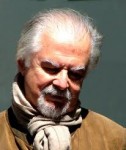
Fernando Botero
Colombian, 1932- (active USA, France, Italy)
Self-Portrait with Still Life, 1979
pencil, heightened with white chalk
13 3/4 x 16 3/4 in.
SBMA, Gift of Mary and Leigh Block
1987.58.15

Photo of Botero 2006
“Art is a spiritual, immaterial respite from the hardships of life”
“A painted landscape is always more beautiful than a real one, because there's more there. Everything is more sensual, and one takes refuge in its beauty. And man needs spiritual expression and nourishing. It's why even in the prehistoric era, people would scrawl pictures of bison on the walls of caves. Man needs music, literature, and paintin - all those oases of perfection that make up art - to compensate for the rudeness and materialism of life.”
-Fernando Botero
COMMENTS
Fernando Botero's distinctive style of smooth inflated shapes with unexpected shifts in scale is today instantly recognizable. It reflects the artist's constant search to give volume presence and reality. The parameters of proportion in his world are innovative and almost always surprising. Appropriating themes from all of art history-- from the Middle Ages, the Italian quattrocento, and Latin American colonial art to the modern trends of the 20th century--Botero transforms them to his own particular style.
Born in 1932 in Medellin, Colombia, Botero became interested in painting at an early age. His artistic precocity was evident in an illustrated article he contributed to the Medellin newspaper El Colombiano when he was seventeen. Titled Picasso and the Nonconformity of Art it revealed his avant-garde thinking about modern art. Botero moved to Bogotá in 1951 and held his first one-man exhibition there at the Leo Matiz Gallery. The following year, at the age of twenty, he was awarded a Second Prize at the National Salon in Bogota.
With the money he earned from the Salon award and his exhibitions, Botero traveled to Spain, France and Italy to study the work of the old masters. In Madrid, he visited El Prado Museum daily while studying at the San Fernando Academy. In Florence, he studied at the Academy of San Marcos and was profoundly influenced by the works of Giotto, Piero della Francesca, Paolo Uccello and Andrea del Castagno.
It was during a brief stay in Mexico that Botero produced Still Life with Mandolin (1956), the first work in which "puffed-up" form makes a definite appearance. Two years later he was awarded a First Prize at the National Salon in Bogota for his Bridal Chamber: Homage to Mantegna, a work inspired in Mantegna's 1474 frescoes for the Ducal Palace in Mantua.
Botero later did a second version on this theme, which is now in the collection of the Hirshhorn Museum. Botero moved to New York in 1960 and the following year the Museum of Modern Art of New York acquired his painting Mona Lisa, Age Twelve for its collection. During this period he experimented briefly with a gestural brushstroke, which Botero called his flirtation with the School of New York. Over the next years Botero continued to explore the manipulation of form for aesthetic effect, gradually eliminating all traces of brushwork and texture, opting instead for smooth inflated shapes.
His continuing attraction to the Colombia of his youth is reflected in paintings rooted in small town Colombian life--middle-class family groups, heads of state, prelates, madonnas, military men, prostitutes and opulent still lifes with exotic fruit. In 1973 Botero left New York for Paris and began to produce sculpture, although without giving up painting. His work in a three-dimensional art was a natural progression for an artist singularly dedicated to expressing volume and mass.
It is not the semblance of volume, however, but volume itself, a tangible volume, that the medium of sculpture offers. His vision involves the conviction that monumentality is not so much a question of size as it is of proportion. It is a search for the heroic in art, an attribute that Botero first discovered as a student in Florence. Today Fernando Botero divides his time between Paris, New York and Tuscany. His paintings, sculptures, and drawings are exhibited and represented in museum collections throughout the world.
http://rogallery.com/Botero/botero-bio.htm
SBMA CURATORIAL LABELS
Fernando Botero was among the first Colombian artists to adopt neofiguration in the 1950s, breaking with the Mexican-derived social realism that had dominated the nation’s contemporary art since the 1940s. He developed a distinctive figurative style of volumetric exaggeration and distortion. Blending realism and caricature, Botero brings a new approach to social satire with his plump figures and objects.
Botero’s discrepancies in scale have been compared to fellow countryman Gabriel García Márquez’s literary style of Magical Realism, which expands reality to encompass myth, magic, and other extraordinary natural phenomena. In Self-Portrait with Still Life, Botero combines the genres of still life and portraiture, and challenges the conventions of each. The artist’s self-portrait is relegated to the background and blends seamlessly with the rounded fruits and bottle arranged in front.
- SBMA title card, 2013
